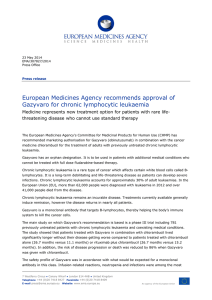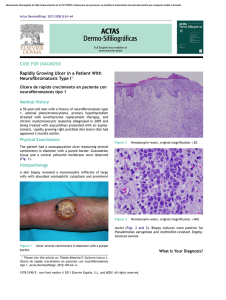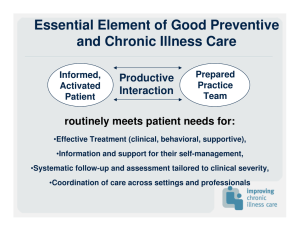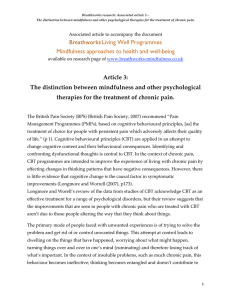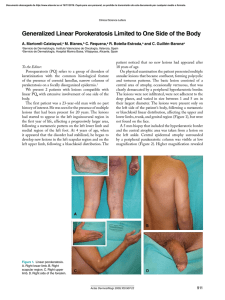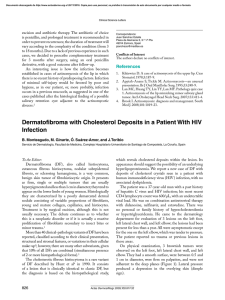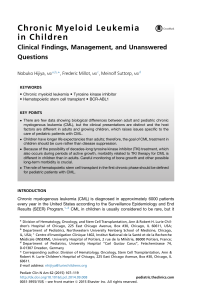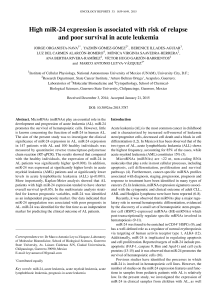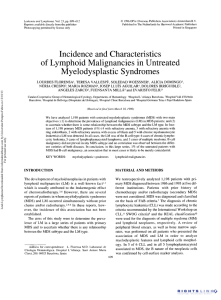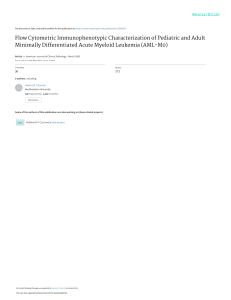Specific Palatal Infiltration in B-Cell Chronic Lymphocytic
Anuncio
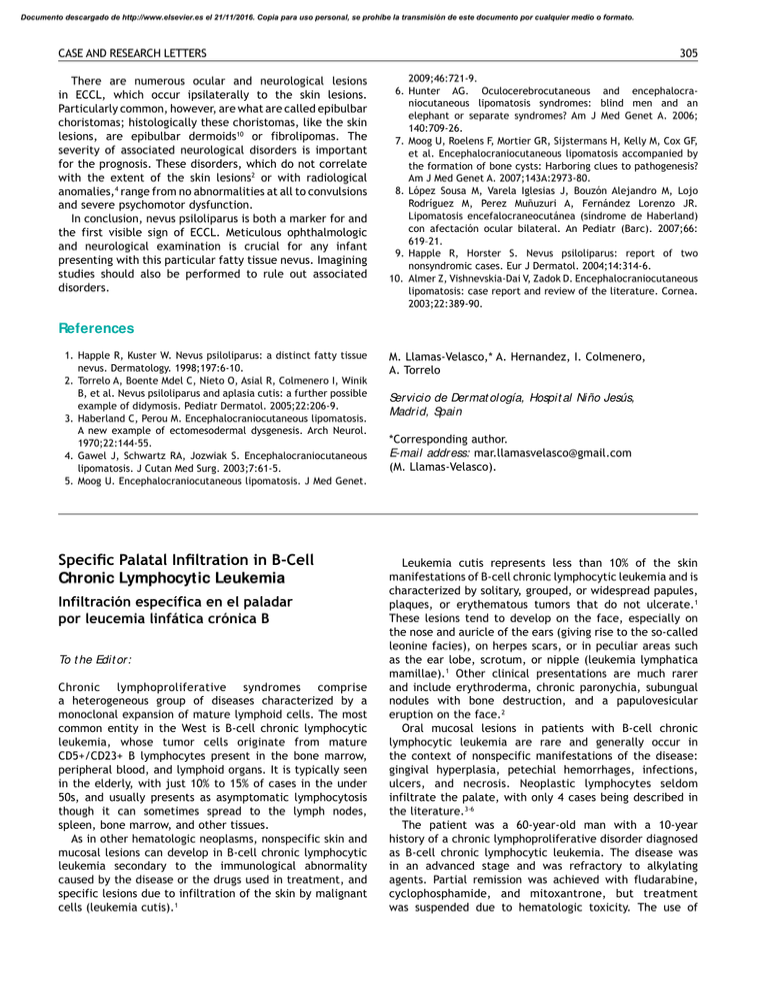
Documento descargado de http://www.elsevier.es el 21/11/2016. Copia para uso personal, se prohíbe la transmisión de este documento por cualquier medio o formato. CASE AND RESEARCH LETTERS There are numerous ocular and neurological lesions in ECCL, which occur ipsilaterally to the skin lesions. Particularly common, however, are what are called epibulbar choristomas; histologically these choristomas, like the skin lesions, are epibulbar dermoids10 or fibrolipomas. The severity of associated neurological disorders is important for the prognosis. These disorders, which do not correlate with the extent of the skin lesions2 or with radiological anomalies,4 range from no abnormalities at all to convulsions and severe psychomotor dysfunction. In conclusion, nevus psiloliparus is both a marker for and the first visible sign of ECCL. Meticulous ophthalmologic and neurological examination is crucial for any infant presenting with this particular fatty tissue nevus. Imagining studies should also be performed to rule out associated disorders. 305 2009;46:721-9. 6. Hunter AG. Oculocerebrocutaneous and encephalocraniocutaneous lipomatosis syndromes: blind men and an elephant or separate syndromes? Am J Med Genet A. 2006; 140:709-26. 7. Moog U, Roelens F, Mortier GR, Sijstermans H, Kelly M, Cox GF, et al. Encephalocraniocutaneous lipomatosis accompanied by the formation of bone cysts: Harboring clues to pathogenesis? Am J Med Genet A. 2007;143A:2973-80. 8. López Sousa M, Varela Iglesias J, Bouzón Alejandro M, Lojo Rodríguez M, Perez Muñuzuri A, Fernández Lorenzo JR. Lipomatosis encefalocraneocutánea (síndrome de Haberland) con afectación ocular bilateral. An Pediatr (Barc). 2007;66: 619–21. 9. Happle R, Horster S. Nevus psiloliparus: report of two nonsyndromic cases. Eur J Dermatol. 2004;14:314-6. 10. Almer Z, Vishnevskia-Dai V, Zadok D. Encephalocraniocutaneous lipomatosis: case report and review of the literature. Cornea. 2003;22:389-90. References 1. Happle R, Kuster W. Nevus psiloliparus: a distinct fatty tissue nevus. Dermatology. 1998;197:6-10. 2. Torrelo A, Boente Mdel C, Nieto O, Asial R, Colmenero I, Winik B, et al. Nevus psiloliparus and aplasia cutis: a further possible example of didymosis. Pediatr Dermatol. 2005;22:206-9. 3. Haberland C, Perou M. Encephalocraniocutaneous lipomatosis. A new example of ectomesodermal dysgenesis. Arch Neurol. 1970;22:144-55. 4. Gawel J, Schwartz RA, Jozwiak S. Encephalocraniocutaneous lipomatosis. J Cutan Med Surg. 2003;7:61-5. 5. Moog U. Encephalocraniocutaneous lipomatosis. J Med Genet. Speciic Palatal Iniltration in B-Cell Chronic Lymphocytic Leukemia Infiltración específica en el paladar por leucemia linfática crónica B To t he Edit or: Chronic lymphoproliferative syndromes comprise a heterogeneous group of diseases characterized by a monoclonal expansion of mature lymphoid cells. The most common entity in the West is B-cell chronic lymphocytic leukemia, whose tumor cells originate from mature CD5+/CD23+ B lymphocytes present in the bone marrow, peripheral blood, and lymphoid organs. It is typically seen in the elderly, with just 10% to 15% of cases in the under 50s, and usually presents as asymptomatic lymphocytosis though it can sometimes spread to the lymph nodes, spleen, bone marrow, and other tissues. As in other hematologic neoplasms, nonspecific skin and mucosal lesions can develop in B-cell chronic lymphocytic leukemia secondary to the immunological abnormality caused by the disease or the drugs used in treatment, and specific lesions due to infiltration of the skin by malignant cells (leukemia cutis).1 M. Llamas-Velasco,* A. Hernandez, I. Colmenero, A. Torrelo Servicio de Dermat ología, Hospit al Niño Jesús, Madrid, Spain *Corresponding author. E-mail address: [email protected] (M. Llamas-Velasco). Leukemia cutis represents less than 10% of the skin manifestations of B-cell chronic lymphocytic leukemia and is characterized by solitary, grouped, or widespread papules, plaques, or erythematous tumors that do not ulcerate.1 These lesions tend to develop on the face, especially on the nose and auricle of the ears (giving rise to the so-called leonine facies), on herpes scars, or in peculiar areas such as the ear lobe, scrotum, or nipple (leukemia lymphatica mamillae).1 Other clinical presentations are much rarer and include erythroderma, chronic paronychia, subungual nodules with bone destruction, and a papulovesicular eruption on the face.2 Oral mucosal lesions in patients with B-cell chronic lymphocytic leukemia are rare and generally occur in the context of nonspecific manifestations of the disease: gingival hyperplasia, petechial hemorrhages, infections, ulcers, and necrosis. Neoplastic lymphocytes seldom infiltrate the palate, with only 4 cases being described in the literature.3-6 The patient was a 60-year-old man with a 10-year history of a chronic lymphoproliferative disorder diagnosed as B-cell chronic lymphocytic leukemia. The disease was in an advanced stage and was refractory to alkylating agents. Partial remission was achieved with fludarabine, cyclophosphamide, and mitoxantrone, but treatment was suspended due to hematologic toxicity. The use of Documento descargado de http://www.elsevier.es el 21/11/2016. Copia para uso personal, se prohíbe la transmisión de este documento por cualquier medio o formato. 306 rituximab, on some occasions associated with fludarabine, also failed to control the leukemia, and a bone marrow transplant could not be performed because none of the patient’s relatives were HLA compatible. Five years earlier, as a complication of the disease, the patient had presented a pure red-cell aplasia with a hemolytic component and autoantibodies in serum and red blood cells; treatment with steroids and cyclosporin was required and the use of alemtuzumab was thus contraindicated. Dermatology consultation was requested for an 8-week history of an asymptomatic, slow-growing tumor on the palate. Examination revealed a lobulated tumor, present on the soft palate on both sides of the midline. The tumor measured around 3 cm in diameter, was of firm consistency, erythematous, and shiny, and was not ulcerated (Figure 1). In addition, there was a widespread palpable lymphadenopathy and hepatosplenomegaly due to the lymphoproliferative disorder. Histology showed a dense, diffuse monomorphic infiltrate in the dermis and subcutaneous cell tissue, consisting of small lymphocytes (Figure 2) that was positive for to CD20 (Figure 3) and CD79a. Due to the asymptomatic nature of the lesion and to the underlying disease no specific treatment was prescribed for the palatal nodule, and the patient continued with the systemic therapy administered by the hematology department (rituximab, fludarabine, steroids, and cyclosporin). Despite this, the disease progressed and the patient died a few months later. Specific infiltration of the oral cavity in B-cell chronic lymphocytic leukemia is unusual but has been described in the gingival mucosa, salivary glands, uvula, and very rarely in the palate.3-6 The patients in those 4 previously published articles and our patient presented with a painless, nonulcerated mass of varying consistency, located on both sides of the midline on the soft and hard palates. Although such a limited number of cases means we cannot be sure that this is the typical form of presentation of specific palatal infiltration due to B-cell chronic lymphocytic leukemia, this possibility should be considered in the event of a mass of such characteristics. Optical microscope study reveals lymphoid infiltrates in the dermis and subcutaneous cell tissue, with a bandlike, multinodular or diffuse perivascular and periadnexal pattern.1 The infiltrate is monomorphic and composed of small lymphocytes with round nuclei, dense chromatin, small nucleoli, and scant cytoplasm.1 The immunophenotype is of the B line, aberrant, and relatively heterogenous: CD20+, CD5+, CD43+, CD23+, CD19+, CD79a+, with monoclonal immunoglobulin light chain expression and possible loss of some markers.1 In most cases, the molecular study shows a monoclonal rearrangement of the immunoglobulin heavy chains.1 Small numbers of reactive cells such as eosinophils, neutrophils, histiocytes, and plasma cells can also be observed.1 The differential diagnosis principally includes benign lymphoid follicular hyperplasia and other lymphomas that can infiltrate the palate. Benign lymphoid follicular hyperplasia, which affects the hard palate and can present with lymphadenopathy, produces clinically similar lesions presenting as lobulated and painless submucosal masses. CASE AND RESEARCH LETTERS Figure 1 Lesion on the palate. Figure 2 Diffuse, dense iniltrate of small lymphocytes. Hematoxylin-eosin, original magniication ×200. Figure 3 ositive staining for CD20. Documento descargado de http://www.elsevier.es el 21/11/2016. Copia para uso personal, se prohíbe la transmisión de este documento por cualquier medio o formato. CASE AND RESEARCH LETTERS Histopathology, however, is different and consists of infiltrates with lymphoid follicles with multiple germinal centers.7 Specific palatal infiltration by other types of lymphoma usually causes unilateral, hard, painful, ulcerated masses with significant bone destruction; once again the pathology study allows these conditions to be identified.8 Although clinically they can be confused with an abscess, squamous cell carcinoma, or salivary gland tumors, the histology is logically very different. The prognosis and treatment of leukemia cutis depend on the underlying disease.1 Ablative treatments (surgery, carbon dioxide laser), interferon, and radiotherapy are used in solitary or isolated lesions. For more extensive or disseminated lesions treatment can be administered with rituximab or various combinations of chemotherapy. Conlict of Interest The authors declare no conflict of interest. References 1. Cerroni L, Zenahlik P, Höler G, Kaddu S, Smolle J, Kerl H. Speciic cutaneous iniltrates of B-cell chronic lymphocytic leukemia: a clinicopathologic and prognostic study of 42 patients. Am J Surg Pathol. 1996;20:1000-10. 2. Beuchner S, Su D. Chronic lymphocytic leukemia, B-cell Type (B-CLL). In Burg G, Kempf W Cutaneous lymphoma. Taylor and Francis Group 2005;375-8. 6000 Broken Sound Parkway NW, Suite 300. Boca Raton, Florida 33487-2742. 307 3. Chaudhry AP, Sabes WR, Gorlin RJ. Unusual oral manifestations of chronic lymphatic leukemia. Report of a case. Oral Surg Oral Med Oral Pathol. 1962;15:446-9. 4. Henefer EP, Nelson JF, Beaupre EM. Palatal enlargement in chronic lymphocytic leukemia: report of case. J Oral Surg. 1970; 28:371-5. 5. Porter SR, Matthews RW, Scully C. Chronic lymphocytic leukaemia with gingival and palatal deposits. J Clin Periodontol. 1994;21:559-61. 6. Vibhute P, Carneiro E, Genden E, Som PM. Palatal enlargement in chronic lymphocytic leukemia. Am J Neuroroadiol. 2006;27: 1649-50. 7. Menasce LP, Shanks JH, Banerjee SS, Harris M. Follicular lymphoid hyperplasia of the hard palate and oral mucosa: report of three cases and a review of the literature. Histopathology. 2001;39:353-8. 8. Ratech H, Burke JS, Blayney DW, Sheibani K, Rappaport H. A clinicopathologic study of malignant lymphomas of the nose, paranasal sinuses and hard palate, including cases of lethal midline granuloma. Cancer. 1989;64:2525-31. I. Cervigón,a,* Á. Palomo,a L.M. Torres-Iglesias,a F. Solano,b A.M. Zapatac a Servicio de Dermat ología, Hospit al Nuest ra Señora del Prado, Talavera de la Reina, Toledo, Spain b Servicio de Hemat ología, Hospit al Nuest ra Señora del Prado, Talavera de la Reina, Toledo, Spain c Servicio de Anat omía Pat ológica, Hospit al Nuest ra Señora del Prado, Talavera de la Reina, Toledo, Spain *Corresponding author. E-mail address: [email protected] (I. Cervigón).
